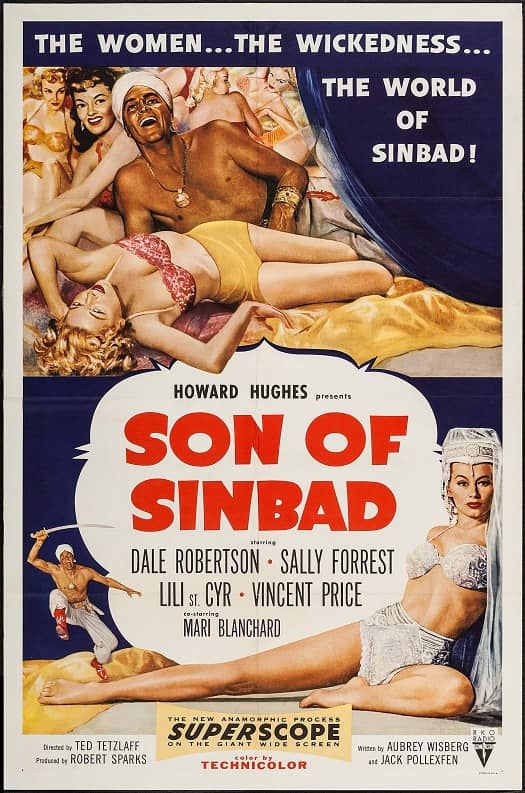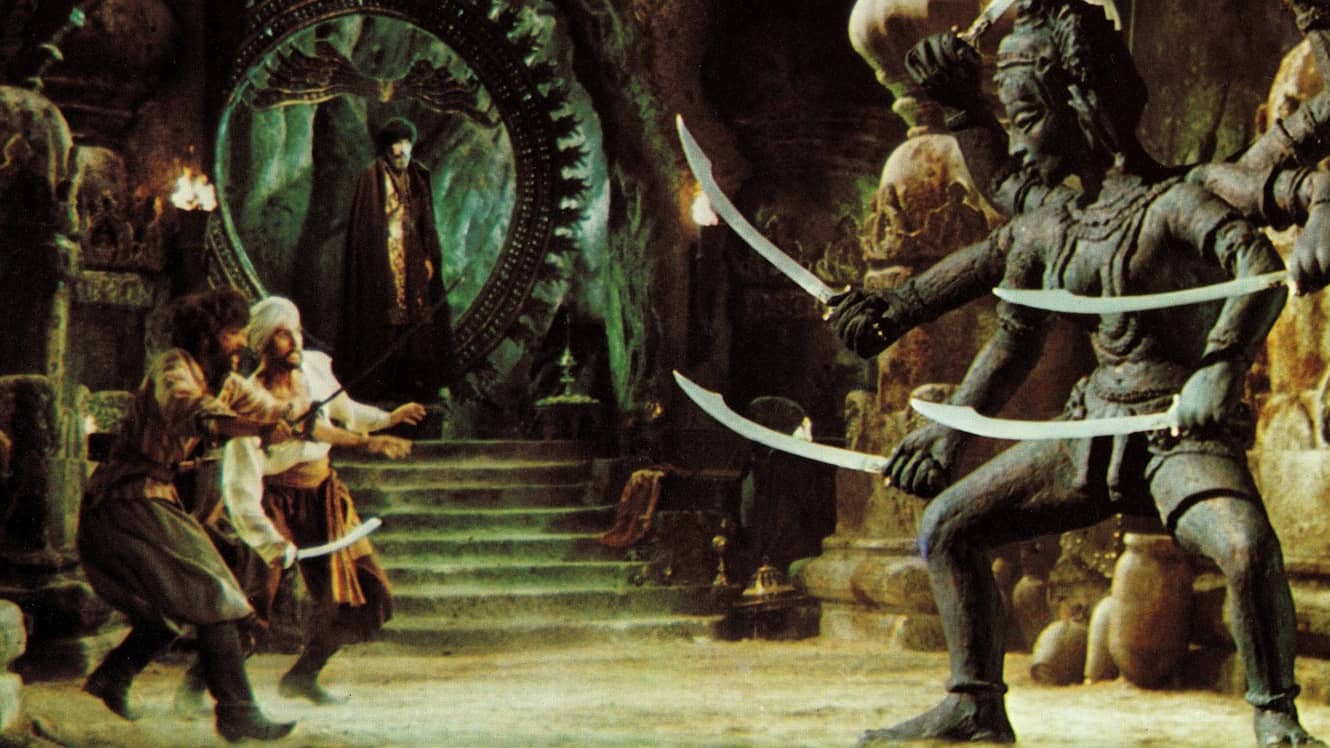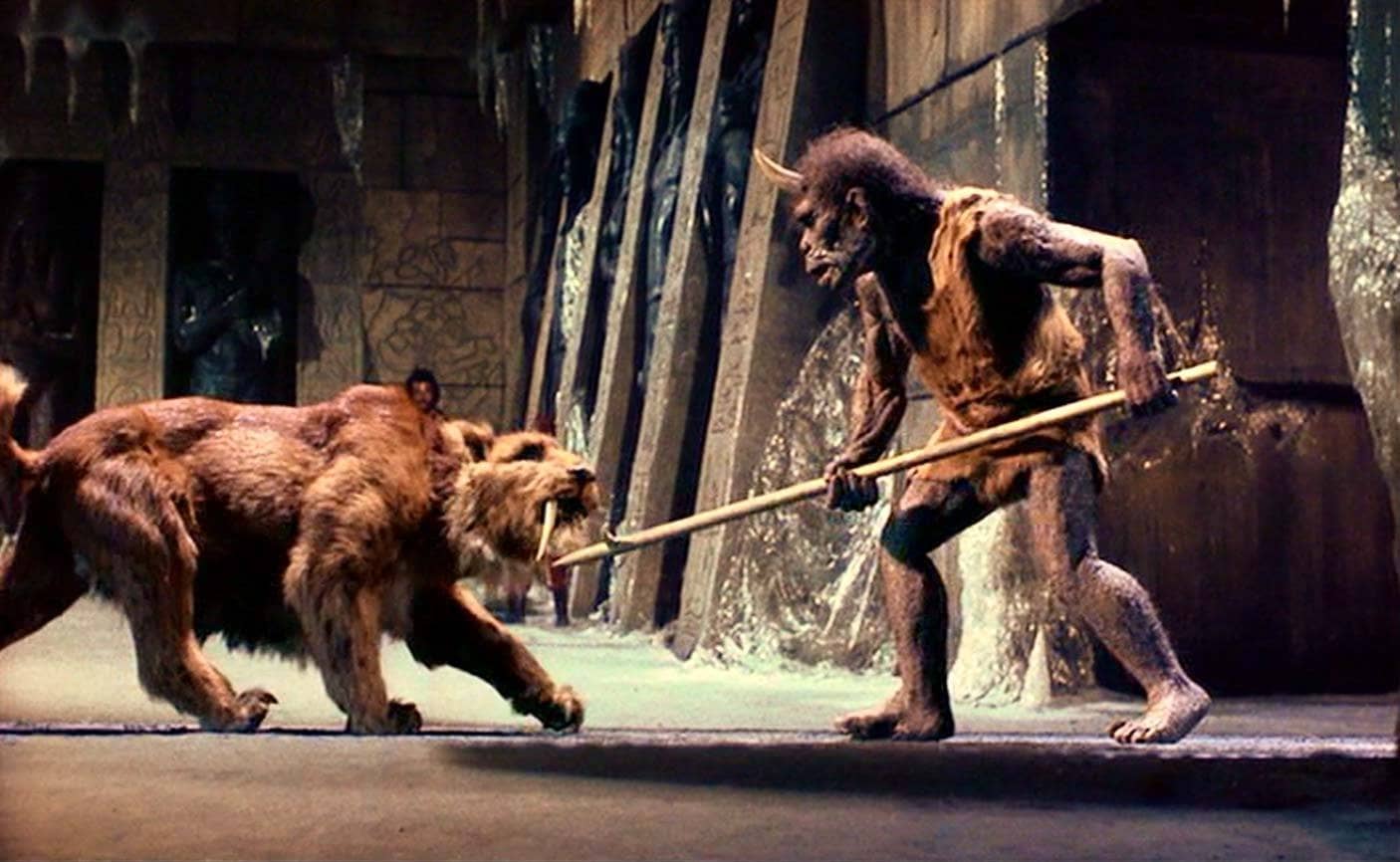Ellsworth’s Cinema of Swords: Sinbads Three
Son of Sinbad (USA, 1955)
Sinbad movies loom so large in the history of fantasy film that it’s remarkable there weren’t more of them — only six or seven live-action features from the Forties through the Seventies. Before the sword-and-sorcery boom of the Eighties, if you wanted to watch a film of heroic fantasy, the first thing you reached for probably had Sinbad in its title.
We’ve already covered three of them in this series: Sinbad the Sailor (1947), The 7th Voyage of Sinbad (1958), and Captain Sindbad (1963), but we still have three to go, and two of them are by the moviemaker most closely associated with the most splendid of Sinbad movies: Ray Harryhausen. Unfurl your lateen sails for adventure!
Son of Sinbad
Rating: **
Origin: USA, 1955
Director: Ted Tetzlaff
Source: Turner Classic Movies
Bagdad buddy-picture, with Dale Robertson as the skirt-chasing Sinbad, son of Sinbad, and Vincent Price as his wise-cracking poet pal Omar Khayyam. This is one of the last films produced by Howard Hughes, so it’s also a jiggling boobfest that was condemned by the Catholic Legion of Decency, featuring about five-score would-be Jane Russells, the stripper Lili St. Cyr, and four “exotic” dance routines right off the burlesque stage.
Nobody in this film is from the Middle East, or even east of New Jersey: cowboy star Robertson’s Oklahoma accent is as broad as the panhandle, and Price even imitates it mockingly in their first scene together. But he’s not the only one, as Murad, the envoy of the Mongols, sounds like he just rode in from Dodge City, and the guards running around in turbans and waving scimitars were just the week before wearing cowboy hats and waving six-guns in Westerns.
But is there any swashbuckling? A bit. Sinbad’s hobby is intruding into the harem of the Caliph of Bagdad, a practice that eventually gets him and his pal Omar captured and condemned. Fortunately, also in the line of captives is an old friend of Sinbad’s father, a sage who knows the secret of Greek Fire and has passed it along to his daughter Kristina (Mari Blanchard). This suddenly becomes important when the aforesaid Murad arrives as herald of the host of Tamerlane, demanding “Submission or the sword!”
Sinbad proposes that the Caliph free Kristina and her father, with him and Omar into the bargain, so they can use the sage’s Greek Fire to fend off the Mongols, but the Caliph’s jester Jiddah (Jay Novello) is a spy for Tamerlane, so Kristina gets abducted, and things get complicated. Sinbad and Omar set out to save both her and the secret of Greek Fire, scimitars are waved, and Mongols are incinerated. Also, dancing.
If you’re one of those viewers who can’t get enough of Vincent Price, I sympathize with that, and this movie is very much for you, because Price fires off poetical quips and does wide-eyed double-takes in nearly every scene. But if you’re not, steer clear and find another caravan. “The moving finger writes, and having writ, moves on.”
The Golden Voyage of Sinbad
Rating: ****
Origin: UK, 1973
Director: Gordon Hessler
Source: Viavision Blu-Ray
Golden Voyage is beloved by fantasy film fans for its fabulous creatures animated in stop-motion by Ray Harryhausen, but its hallmark monsters aside, this is one strange movie. The story is a sort of stately parade of wonders with a plot that makes sense only in the terms of dream logic. Sinbad (John Philip Law, bland but with a nice smile) happens upon one-third of a magical golden amulet, and thereafter is led by visions and visitations on a quest for… what? Some goal that, despite a superfluity of prophecies and portents, is never really made clear. Wealth? Power? Experience points?
Maybe it’s the latter, because Sinbad and company are basically a Dungeons & Dragons adventure party, his crew reminiscent of the clichéd squad members in every war movie, only with Arabian Nights names like Haroun and Omar. They’re joined by Caroline Munro as Margiana because she’s the hottest thing in harem pants, and because she has an eye tattooed on her hand that Sinbad saw in a dream, so she must join the crew because Fate or something. The party is rounded out by a grand vizier who conceals his features behind a golden mask because they were destroyed by a fireball from the evil wizard Koura. This vizier joins the quest because somebody has to utter portentous warnings and explain What It All Means.
Which brings us to the aforementioned evil wizard Koura, and here’s where the movie gets interesting. This sorcerer, Sinbad’s arch-rival on the amulet quest, is played by Tom Baker — the Fourth Doctor! — who’s almost unrecognizable in a black turban and face kerchief. But he does more emoting with just his eyes than the rest of the cast put together.
Koura is the wizard who magically animates all the creatures that bedevil Sinbad and company, but every time he casts a spell, he visibly ages, dwindling toward death, and soon it becomes clear that he wants the magical amulet’s prize because it will restore his lost youth and stave off his suicide-by-sorcery. This makes Koura the only character in the picture with clear and comprehensible motives, and Baker plays him with such energy and verve that about halfway through the film you found yourself starting to root for the villain.
Koura won me over in the scene where, with a mandrake root, alchemy, and a dollop of his own blood, he animates a tiny, winged homunculus, and suddenly we see that the putative villain is the real heart of this fantasy, a man of passion who breathes life into inanimate matter, creating wonder before our eyes. Yes, you’ve got it: Koura is really Ray Harryhausen himself, literally pouring his life into his creations.
This is even more clear when Koura animates a statue of the six-armed goddess Kali, making it dance for him purely so he can revel in his artistry — or rather Harryhausen’s artistry, for whether dancing or wielding six swords against Sinbad, the slyly smiling Kali is a masterpiece, so wonderful it’s easy to forgive the stretches where the film falls flat.
The script is by Brian Clemens, the English screenwriter behind most of the best moments of the British Avengers TV show, but this outing is weak work, recycled adventure-film tropes and Orientalist clichés. The dialogue is studded with phony wise sayings like “You cannot pick up two melons with one hand,” in which you can hear the snotty British intellectual sneering at the Wisdom of the East. It’s embarrassing.
Eventually the quest leads to the long-lost island of Lemuria, which is cluttered with ruins evoking every ancient Asian culture at once: India, Tibet, Cambodia, China, and so on. It’s meant to imply that the questers have discovered the source of all the cultures of the Mysterious East, but it feels more like, “All those bally foreign temples look alike to me, eh, what what?” It doesn’t help that the Lemurians, when they meet them, are a tribe of green-skinned ooga-booga cannibals with skulls on sticks. Ouch.
But those animated monsters, though! So fabulous. Plus, there’s some wonderfully lush music by Miklós Rósza, contributing one of his last great film scores, and a couple of epic dungeon crawls that I guarantee helped inspire Gary Gygax. Despite its lapses and eccentricities, as fantasy films go, Golden Voyage is still almost indispensable.
Sinbad and the Eye of the Tiger
Rating: ****
Origin: UK, 1977
Director: Sam Wanamaker
Source: Viavision Blu-Ray
After the success of Golden Voyage, Columbia Pictures and Ray Harryhausen decided to up their game by shooting the third Sinbad movie at eye-popping locations in Spain, Malta, and Jordan, including the actual ruins of Petra. Then I guess they figured no further improvements were needed, because they hired mediocre director Sam Wanamaker, a journeyman unable to mitigate the pacing problems of the story, which was already burdened by a dull and generic script from Beverly Cross.
The cast is bland as well, featuring the charisma-free Patrick Wayne (son of John) as Sinbad, and the vacant Taryn Power (daughter of Tyrone) as Dione, the wizard’s telepathic daughter. Jane Seymour as Princess Farah gets to do some decent acting in a couple of early scenes, but then the movie forgets she has any character and demotes her to the role of not-much-clothes horse. The best actors, as usual, are cast as the magicians, Margaret Whiting as the transforming sorceress Zenobia, and Patrick Troughton (the Second Doctor) as Melanthius, gray and looking just like Gandalf minus the hat. The film’s saving grace, as always, is the stop-motion artistry of Harryhausen and his marvelous creatures.
The plot follows the tried-and-true quest structure, with Sinbad and company on a perilous journey to find a cure for Farah’s brother, Prince Kassim, whom Zenobia has transformed into a baboon. This animated primate, with its humanlike gestures and expressions, is entirely convincing, and ranks with Harryhausen’s best work. Zenobia also gets a first-rate animated minion in Minaton, a bronze minotaur golem with a clockwork heart and an endless reservoir of superhuman strength. With the baboon in almost every scene with Sinbad, and Minaton ever-present with Zenobia, Eye of the Tiger probably features more onscreen creature-time than any other Harryhausen epic.
The journey is the usual parade of wonders interrupted by fantasy mêlées. It’s a tribute to Harryhausen’s skill — and an indictment of Wanamaker’s failings — that the animated combats are far better choreographed than the live-action fights. In the middle of the film, as Sinbad’s ship sails toward arctic Hyperborea, pursued by Zenobia in a bronze boat powered by the untiring Minaton, the pacing sags in a miasma of fog, stock footage of icebergs, and a dumb battle with a giant walrus, possibly the least-cool Harryhausen creation ever.0
The pace picks up again when they reach Hyperborea, where Sinbad and friends encounter an over-sized proto-human they call Trog. Instead of the expected combat pitting Trog and his great bone club against the scimitars of Sinbad’s crew, Kassim the baboon befriends the primitive creature, and it trustingly joins their party. The friendly nonverbal interactions between Trog and the baboon that follow are delightful, and the animated creatures establish an emotional connection stronger than any between the movie’s “real” actors.
As usual, the climactic scene is set in an ancient temple, an Arctic pyramid with a magic ever-swirling Jacuzzi inside. This confrontation between good and evil is overlong and entirely predictable, and some fine monster-wrestling notwithstanding, one just wishes they’d hurry up and get it over with. The wrestling comes courtesy of an ice-locked saber-toothed tiger, which in accordance with the Law of Frozen Prehistoric Beasts gets thawed out to menace the heroes.
Once the final fight is over the film blessedly cuts straight to the end credits, which play over the coronation of the rehumanized Prince Kassim, while the rest of the good guys smile in bland approval. That’s fine: we don’t really need any character closure with them anyway, since none of them have half the heart and soul of Harryhausen’s noble beasts.
Where can I watch these movies? I’m glad you asked! Many movies and TV shows are available on disk in DVD or Blu-ray formats, but nowadays we live in a new world of streaming services, more every month it seems. However, it can be hard to find what content will stream in your location, since the market is evolving and global services are a patchwork quilt of rights and availability. I recommend JustWatch.com, a search engine that scans streaming services to find the title of your choice. Give it a try. And if you have a better alternative, let us know.
Previous installments in the Cinema of Swords include:
Flynn’s Last Flourishes
Mighty Colossi And Hydrae
Rejecting Bushido (Part One)
Pirates — Italian Style
The Year of Camelot and Scarecrows
Rejecting Bushido (Part Two)
The Fall of the Hollywood Epic
Cheh’s On Second
En Garde, Old Boy
More Hammer Historicals
Zatoichi’s Finest
A Little History
Lone Wolf and Cub, Part I
Premium Peplum
The Book Was Better
Shogunate’s End
Peak Musketeers
Lone Wolf and Cub, Part 2
Arthur, King of the Britons
LAWRENCE ELLSWORTH is deep in his current mega-project, editing and translating new, contemporary English editions of all the works in Alexandre Dumas’s Musketeers Cycle, with the fifth volume, Between Two Kings, coming in July from Pegasus Books in the US and UK. His website is Swashbucklingadventure.net.
Ellsworth’s secret identity is game designer LAWRENCE SCHICK, who’s been designing role-playing games since the 1970s. He now lives in Dublin, Ireland, where he’s writing Dungeons & Dragons scenarios for Larian Studios’ Baldur’s Gate 3.



Golden Voyage of Sinbad remains probably my favorite Harryhausen movie, although admittedly that’d at least in part because it’s the first one I saw in the theater.
Sinbad and the Eye of the Tiger is … mostly watchable. Oh, and there are a few scenes where Minoton is played by a man in a suit, and that man’s name was Peter Mayhew, and if I have my details right, his role in this movie might’ve been what led to him getting cast in that OTHER movie he did in 1977.
And I think Tom Baker’s performance as Koura might have also led to him taking the helm of the TARDIS.
Always enjoyable, and Caroline Munro is the hottest in whatever she—or isn’t—wearing.
Another Ellsworth’s Cinema of Swords? With Sinbad? and the Great Harryhausen!!!
You had me with the poster, Bwana.
I’ve never seen or even heard of Son of Sinbad, and for the life of me, I have no idea why. Now I MUST see it or that poster will haunt my dreams forever.
I’ve seen both the Harryhausen movies multiple times and while I enjoyed Eye of the Tiger, it is the Golden Voyage that will live in my memories forever (and not JUST because of Caroline Munro). I can’t remember how many times I saw it because the guy managing one of the local theatres put it on rotation every Sunday night that summer. For a pittance me and my buddies could sit down and watch Ray Harryhausen, Caroline Munro and Sinbad the Sailor from midnight to 6 am. I still hear Tom Baker’s voice in my dreams:
“O Mighty Kali, Make Obeisance to Me!”
As for Caroline Munro and my dreams, I really don’t think that’s anyone’s business. Sigh.
Thank you again, Mr. Ellsworth, for a great post and for pointing me at a film I had no idea even existed.